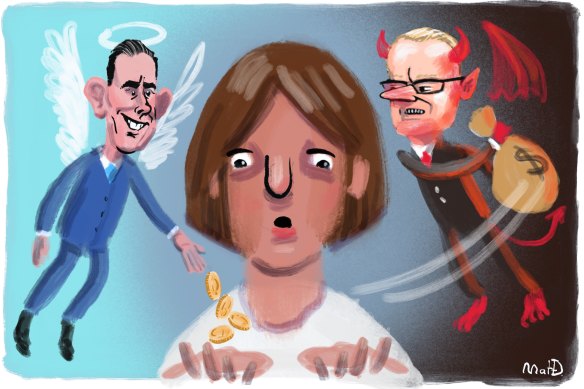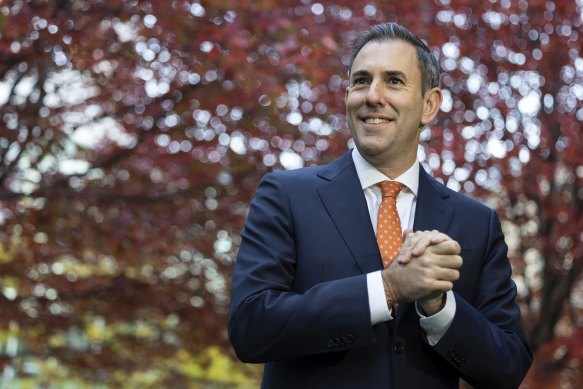Chalmers and Lowe: Good cop, bad cop on the inflation beat

Save articles for later
Add articles to your saved list and come back to them any time.
Have you noticed? There’s a contradiction at the heart of Treasurer Jim Chalmers’ budget. Is it helping or harming inflation?
Both Chalmers and Reserve Bank governor Dr Philip Lowe are agreed that our top priority must be to get the rate of inflation down. That’s fine. Everybody hates the way prices have been shooting up. The cost of living has become impossible. Do something!
Credit:
But while Lowe seems to be just making it all worse, jacking up mortgage interest rates higher and higher, nice Mr Chalmers is using his budget to take a bit of the pressure off, helping with electricity bills, cutting prescription costs and so on.
It’s as though Lowe is the arsonist, sneaking round the bush to start more fires, while Chalmers is the Salvos, turning up at the scene to give the tired firefighters a kind word, a pie and a cup of tea.
Is that how you see it? That’s the way Chalmers wants you to see it, and Lowe knows full well it’s his job to be Mr Nasty at times like this.
But what on earth’s going on? Has the world gone crazy? No, it’s just the usual dance between brutal economics on one hand, and always-here-to-help politics on the other.
Let’s start from scratch. Why do we have an inflation problem? Because, for the past 18 months or so, the prices of the things we buy have been shooting up, rising much faster than our wages, causing the cost of living to become tough for many people.
Why have prices been rising so rapidly? Partly because the COVID-19 pandemic and Russia’s attack on Ukraine caused international shortages of building materials, cars, computer chips and fossil fuels. But also because the massive increase in our governments’ payments during the pandemic left us cashed up and spending big on locally made goods and services.
When the suppliers of the stuff we buy can’t keep up with our demand for it, they raise their prices. The media may call this “price gouging”, but economists believe it’s what happens naturally in a market economy – and should happen because the higher price gives the suppliers an incentive to produce more. When they do, the price will come down.
Playing Mr Nice Guy, Treasurer Jim Chalmers.Credit: Alex Ellinghausen
When inflation takes off like this, what can the managers of the economy do to stop prices rising so fast? They can do nothing to magically increase supply; that takes time. But what they can do is reduce demand – discourage us from spending so much.
How? This is where it gets nasty. By squeezing households’ finances so hard they have to cut their spending. Once demand for the stuff they’re selling falls back, businesses are much less keen to raise their prices.
At present, households are being squeezed from all directions. The main way is that wages aren’t keeping up with the rise in prices. As well, more of the wage rises people are getting is being eaten up by income tax, thanks to “bracket creep”.
And the fall in house prices means home-owning households aren’t feeling as wealthy as they were.
All that’s before you get to Mr Nasty, raising the interest rates paid by people with mortgages, which is particularly tough on young home owners, with more recent, much bigger mortgages.
(You may wonder if this extra pressure on, say, only about 20 per cent of all households is either fair or the most effective way to get total household spending to slow. And you may be right, but you’d be way ahead of the world’s economists, who think the way they’ve always done it is the only way they could do it.)
But what part is the budget – “fiscal policy” – supposed to play in all this? It should be helping put the squeeze on, not reducing it. Now do you see why some are questioning whether Chalmers’ $14.6 billion “cost-of-living relief package” will help or hinder the cause of lower inflation?
The budget balance shows whether government spending is putting more money into the economy, and its households, than it’s taking out in taxes. If so, the budget’s running a deficit. If it’s taking more money out than it’s put back in, the budget’s running a surplus.
Reserve Bank governor Philip Lowe – the nasty one.Credit: AAP
The way the Reserve Bank judges whether the budget is increasing the squeeze on households, or easing it, is to look at the size and direction of the expected change in budget balance from one year to the next.
The budget papers show the budget balance is planned to change from an actual deficit of $32 billion last financial year, 2021-22, to an expected surplus of $4 billion in this financial year, ending next month.
That’s an expected tightening of $36 billion, equivalent to 1.6 per cent of the size of the whole economy, gross domestic product.
No doubt such a change is adding a big squeeze to household incomes. But then the budget balance is expected to worsen in the coming financial year, 2023-24, to a deficit of $14 billion. That’s an easing of pressure on households’ finances equivalent to 0.7 per cent of GDP.
Put the two years together, however, and its clear the budget will still be putting a lot of squeeze on households – on top of all the other squeeze coming from elsewhere.
Somewhere in there is most of Chalmers’ $14.6 billion relief package. As a matter of arithmetic, it’s undeniably true that, had the package – which, by the way, is expected to reduce the consumer price index by 0.75 percentage points – not happened, the squeeze would be, say, $10 billion tighter than it’s now expected to be.
But there’s no way, looking at that – and all the other sources of squeeze – the Reserve will be saying, gosh, Chalmers is adding to inflation pressure, so we’d better raise rates further.
Chalmers has said the “stance” of fiscal policy adopted in the budget is “broadly neutral”. Not quite. So, I’ll say the nasty word Mr Nice Guy doesn’t want to: the stance is “mildly contractionary”.
Ross Gittins is the economics editor.
The Business Briefing newsletter delivers major stories, exclusive coverage and expert opinion. Sign up to get it every weekday morning.
Most Viewed in Business
From our partners
Source: Read Full Article



